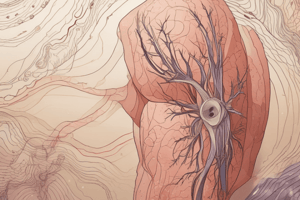Podcast
Questions and Answers
What structures are included in the integumentary system?
What structures are included in the integumentary system?
The integumentary system consists of the skin, hair, oil and sweat glands, nails, and sensory receptors.
How does the process of keratinization occur?
How does the process of keratinization occur?
Newly formed cells in the stratum basale are pushed to the surface, accumulating keratin. They undergo apoptosis, slough off, and are replaced by underlying cells. The process takes about four weeks.
What are the functions of the epidermis?
What are the functions of the epidermis?
Prevents water loss and entry of pathogens, continuous mitosis, produces antimicrobial defensins, changes cholesterol to vitamin D, and protects living skin layers from UV rays.
What are the functions of the dermis?
What are the functions of the dermis?
How are epidermal ridges formed?
How are epidermal ridges formed?
What are the three pigments in the skin and how do they contribute to skin color?
What are the three pigments in the skin and how do they contribute to skin color?
Describe the structure of a hair.
Describe the structure of a hair.
What causes 'goose bumps'?
What causes 'goose bumps'?
Contrast the locations and functions of sebaceous, sudoriferous, and ceruminous glands.
Contrast the locations and functions of sebaceous, sudoriferous, and ceruminous glands.
Describe the parts of a nail.
Describe the parts of a nail.
Flashcards are hidden until you start studying
Study Notes
Integumentary System Overview
- Comprises skin, hair, oil and sweat glands, nails, and sensory receptors.
Keratinization Process
- Cells in stratum basale gradually migrate to skin surface, accumulating keratin.
- This process involves cell death (apoptosis) and takes about four weeks for completion in a typical epidermis of 0.1 mm thickness.
Functions of the Epidermis
- Stratum corneum prevents water loss and entry of pathogens if unbroken.
- Stratum germinativum continually produces new cells; synthesizes vitamin D when exposed to UV light.
- Langerhans cells act in immune response through phagocytosis of foreign materials.
- Merkel cells function as touch receptors.
- Melanocytes produce melanin, protecting deeper skin layers from UV radiation.
Functions of the Dermis
- Papillary layer contains capillaries nourishing the stratum germinativum.
- Hair follicles prevent dust entry and provide insulation.
- Nails protect the tips of fingers and toes from mechanical damage.
- Receptors within dermis enable detection of touch, pressure, heat, cold, itch, and pain.
- Sebaceous glands secrete sebum to maintain skin and hair moisture while inhibiting bacteria.
- Eccrine sweat glands produce sweat to cool the body.
- Arterioles adapt by dilating to lose heat or constricting in cold to conserve body heat.
Formation of Epidermal Ridges
- Form during fetal development as the epidermis projects into the dermis.
- Increase surface area and grip, contributing to fingerprints as sweat pores open on ridges.
Skin Pigments and Skin Color
- Melanin (dark shades), hemoglobin (red from blood), and carotene (yellow-orange) influence skin color.
- The level of melanin dictates skin tone from pale yellow to deep brown.
- Carotene is stored in skin layers, particularly after high dietary intake.
Hair Structure and Goosebumps
- Hair consists of dead, keratinized cells; emerges at an angle from the skin.
- Goosebumps occur when arrector pili muscles contract due to stress, positioning hair shafts upright.
Glandular Functions and Locations
- Sebaceous glands produce sebum, maintaining skin and hair moisture.
- Eccrine sweat glands secrete water for evaporative cooling.
- Ceruminous glands create cerumen to protect and moisturize the eardrum.
Nail Structure
- Nails consist of hard, dead keratinized epidermal cells located on the dorsal surfaces of fingers and toes.
Studying That Suits You
Use AI to generate personalized quizzes and flashcards to suit your learning preferences.



